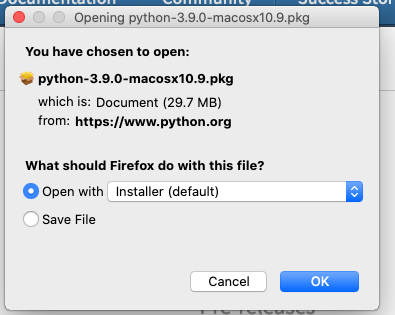On Mac the recommended approach is to use the official Python.org installer. Previously the package manager Homebrew was a great choice–it handled software installs and upgrades elegantly in most cases–but for Python itself there are several serious issues detailed by Justin Mayer in this post. As a result, using the official Python.org installer is now a better option.
Official Installer
How to install Python 3 on a Mac computer. On Mac the recommended approach is to use the official Python.org installer. Previously the package manager Homebrew was a great choice–it handled software installs and upgrades elegantly in most cases–but for Python itself there are several serious issues detailed by Justin Mayer in this post. For most Unix systems, you must download and compile the source code. The same source code archive can also be used to build the Windows and Mac versions, and is the starting point for ports to all other platforms. Download the latest Python 3 and Python 2 source. I want to install pip for python 2.7 on my Mac. I think this is the python located in /usr/bin/python. Unfortunately I have already installed Anaconda, which installs python 3.6.3, and changes things so that the command python xxx.py automatically runs xxx.py using python 3.6.3.
Main development now takes place in the Python standard library: see the Python developer’s guide, and report issues on the Python bug tracker. However, if you find an issue specific to prior versions of Python (such as 2.7 or 3.2), you can post an issue on the BitBucket project page. Installing Packages¶. This section covers the basics of how to install Python packages. It’s important to note that the term “package” in this context is being used to describe a bundle of software to be installed (i.e. As a synonym for a distribution).

Open a new browser window and visit the Downloads page. Click on the button for “Download Python 3.9.5” or whatever the latest version is.
Click “Allow” on the popup asking if you want to allow downloads from “www.python.org.”
Open up a new Finder window (the keyboard shortcut of pressing Command + n will do this) and click on the sidebar for “Downloads.” Then doubleclick on the Python package to install it.
This launches the Python Installer. Click on the “Continue” button.
Next up are several screens. Click “Continue” again on the Read Me page.
Next is the License page. Click “Continue” which will launch a pop up asking if you agree to the terms. Click on “Agree.”
The standard install will save Python to your disk. Click on the “Install” button.
This will launch another pop-up asking for your password. Enter it and click “Install Software.”
Install Glob For Python In Mac Os
After installation is a Summary window. You can hit the “Close” button on this.
A popup will ask if you want to move the Python installer to the trash. Click on “Move to Trash” as we no longer need the installer.
There will also be a new Finder window opened with the Python 3.9 package.
Install Glob Python
IDLE vs Command Line
The simplest way to use Python is via the built-in IDLE. Click on the link for IDLE which launches a new Shell. You can type any command here such as print('Hello, World').

You can also now access Python from the command line. Open up the Terminal application which is located within Applications -> Utilities -> Terminal.
Once open, type python3 to launch the Python interpreter from the command line. When you see the prompt >>> you know it is working. To confirm, type print('Hello, World') again.

Next Steps
Install Glob For Python In Macbook
Two excellent beginner-friendly Python books are Python Crash Course and Automate the Boring Stuff. If you’d like to learn web development with Python, check out Learn Django.